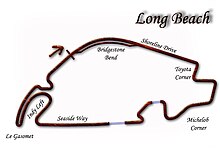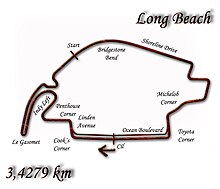United States Grand Prix West
With the east coast Watkins Glen track on the downslope after two fatalities in successive years and a politically charged 1975 event, the USGP West was created for the 1976 season on a tight circuit made up of city streets in Long Beach, California, located in the Los Angeles metropolitan area on the west coast.
Southern California had seen a championship Formula One race before; the 1960 United States Grand Prix was held at the famed Riverside Raceway, which was just an hour's drive from Long Beach.
That race was won by Argentine Carlos Reutemann, and Australian Alan Jones finished a great 2nd place for the new Williams team, their first ever podium position.
But the worst accident was yet to come- Clay Regazzoni in an Ensign crashed appallingly when his brakes failed at 180 mph at the end of Shoreline Drive.
He then hit the wall next to the track and went straight-on past Queen's Hairpin and crashed into retaining tire barriers head-on, still moving extremely quickly.
This race saw Italian Riccardo Patrese take pole position from the dominant Williams duo of Alan Jones and Reutemann; Patrese eventually dropped back with mechanical problems and Reutemann made a mistake at one of the turns on Pine Avenue so Jones slipped by to take the lead, which he held until the checkered flag.
The revised circuit also included a number of tight turns built around the Convention Center and a slightly shortened Le Gasomet hairpin so that Ocean Boulevard could still be used by everyday traffic.
John Watson won from 22nd place on the grid, the farthest back from which a modern Grand Prix driver had ever come to win a race, taking advantage of the front runners retiring and an incident between Rosberg and Frenchman Patrick Tambay.
Rumors persisted during the whole 1983 weekend that race organizer Chris Pook, the main figure in the attempt to create a "Monte Carlo of the United States" in Long Beach, had decided that Formula One was too expensive and risky.
Shipping the F1 equipment all the way over from Europe and Brazil and increased FOCA fees had made the race financially unfeasible, particularly in a country where the financial culture meant that short-term returns on business investments were paramount, and Long Beach had never been paired with any other nearby race in Mexico or elsewhere in the United States, so the costs could not be cut.
Despite tremendous success since the race's inception in 1976, and the observable impact of the global exposure it brought to the city and to the Los Angeles area in general, the organizers believed that the less expensive and domestically more popular CART championship, having mostly American drivers such as Mario Andretti, Rick Mears, and Al Unser, would be a more promising investment.
[1][2] However, on April 1, 2014, the Long Beach City Council informed the race's organizer that the IndyCar Series had been granted a three-year extension, through the 2018 season.



